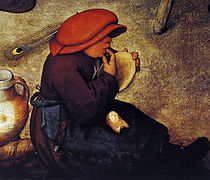The groom
There has been much conjecture as to the identity of the groom in this painting. The critics Gilbert Highet and Gustav Glück have argued that the groom is the man in the centre of the painting, wearing a dark coat and seen in profile, [5] [6] or the ill-bred son of a wealthy couple, seen against the far wall to the right of the bride, eating with a spoon. [7] It has also been suggested that according to contemporary custom, the groom is not seated, but may be the man pouring out beer. [8]
According to the same custom, he may also be the man handing the plates of food to his guests from the near end of the table, wearing a red cap. [9]
In a Freudian vein, Rudy Rucker speculates: [10]
... the groom is the man in the red hat, passing food towards the bride. The motion of a husband, to penetrate the wife. Near him are no less than three phallic symbols pointing towards the wife: the man’s arm, the knife on the table, and the salt-cellar [salt shaker] on the table. At the end of the man’s arm is an ellipse of an angle-seen dish that is oriented and located in the right location to represent the bride’s vagina. [11]
Some authors have even suggested that the groom is not even included in the painting. Van der Elst speculated that this could be the depiction of an old Flemish proverb: It is a poor man who is not able to be at his own wedding. [12] Some connect it with the biblical Wedding of Cana. [4] Lindsay and Bernard Huppé speculated that the painting was a Christian allegory of corruption, depicting the corrupted Church destined to be the bride of Christ, but the groom has not appeared to claim his corrupt bride. [13]

Pieter Brueghelthe Younger was a Flemish painter known for numerous copies after his father Pieter Bruegel the Elder's work, as well as original compositions and Bruegelian pastiches. The large output of his studio, which produced for the local and export market, contributed to the international spread of his father's imagery.

Pieter Bruegelthe Elder was among the most significant artists of Dutch and Flemish Renaissance painting, a painter and printmaker, known for his landscapes and peasant scenes ; he was a pioneer in presenting both types of subject as large paintings.

The Triumph of Death is an oil panel painting by Pieter Bruegel the Elder painted c. 1562. It has been in the Museo del Prado in Madrid since 1827.

The Kunsthistorisches Museum Wien is an art museum in Vienna, Austria. Housed in its festive palatial building on the Vienna Ring Road, it is crowned with an octagonal dome. The term Kunsthistorisches Museum applies to both the institution and the main building. It is the largest art museum in the country and one of the most important museums worldwide.

The Harvesters is an oil painting on wood completed by Pieter Bruegel the Elder in 1565. It depicts the harvest time set in a landscape, in the months of July and August or late summer. Nicolaes Jonghelinck, a merchant banker and art collector from Antwerp, commissioned this painting as part of a cycle of six paintings depicting various seasonal transitions during the year.
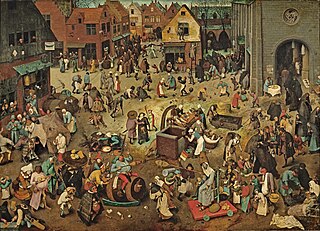
The Fight Between Carnival and Lent is an oil-on-panel painting executed by the Dutch and Flemish Renaissance painter Pieter Bruegel the Elder in 1559. It is a panorama of contemporary life in the Southern Netherlands. While the painting contains nearly 200 characters, it is unified under the theme of the transition from Shrove Tuesday to Lent, the period forty days before Easter.
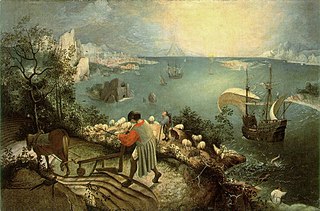
Dutch and Flemish Renaissance painting represents the 16th-century response to Italian Renaissance art in the Low Countries, as well as many continuities with the preceding Early Netherlandish painting. The period spans from the Antwerp Mannerists and Hieronymus Bosch at the start of the 16th century to the late Northern Mannerists such as Hendrik Goltzius and Joachim Wtewael at the end. Artists drew on both the recent innovations of Italian painting and the local traditions of the Early Netherlandish artists.
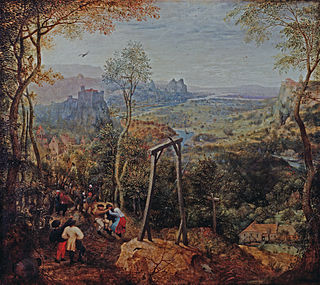
The Magpie on the Gallows is a 1568 oil-on-wood panel painting by the Netherlandish Renaissance artist Pieter Bruegel the Elder. It is now in the Hessisches Landesmuseum, in Darmstadt.

Netherlandish Proverbs is a 1559 oil-on-oak-panel painting by Pieter Bruegel the Elder that depicts a scene in which humans and, to a lesser extent, animals and objects, offer literal illustrations of Dutch-language proverbs and idioms.

Marten van Cleve the Elder was a Flemish painter and draftsman active in Antwerp between 1551 and 1581. Van Cleve is mainly known for his genre scenes with peasants and landscapes, which show a certain resemblance with the work of Pieter Bruegel the Elder. Marten van Cleve was one of the leading Flemish artists of his generation. His subjects and compositions were an important influence on the work of Pieter Brueghel the Younger and other genre painters of his generation.

The Blind Leading the Blind, Blind, or The Parable of the Blind is a painting by the Netherlandish Renaissance artist Pieter Bruegel the Elder, completed in 1568. Executed in distemper on linen canvas, it measures 86 cm × 154 cm. It depicts the Biblical parable of the blind leading the blind from the Gospel of Matthew 15:14, and is in the collection of the Museo di Capodimonte in Naples, Italy.

Het Luilekkerland — known in English as The Land of Cockaigne — is a 1567 oil painting by Pieter Bruegel the Elder. In medieval times, Cockaigne was a mythical land of plenty, but Bruegel's depiction of Cockaigne and its residents is not meant to be a flattering one. He chooses rather a comic illustration of the spiritual emptiness believed to derive from gluttony and sloth, two of the seven deadly sins.

Peeter Baltens, Pieter Balten or Pieter Custodis, was a Flemish Renaissance painter, draughtsman, engraver and publisher. Baltens was also active as an art dealer and poet. He was known for his genre paintings, religious compositions and landscapes.

The Adoration of the Kings is an oil-on-panel painting of the Adoration of the Magi by the Netherlandish Renaissance artist Pieter Bruegel the Elder, painted in 1564. It is held in the National Gallery, in London.

The Peasant Dance is an oil-on-panel by the Netherlandish Renaissance artist Pieter Bruegel the Elder, painted in circa 1567. It was looted by Napoleon Bonaparte and brought to Paris in 1808, being returned in 1815. In is now in the Kunsthistorisches Museum in Vienna.

The Peasant and the Nest Robber is an oil-on-panel painting by the Netherlandish Renaissance artist Pieter Bruegel the Elder, painted in 1568. It is in the Kunsthistorisches Museum in Vienna.
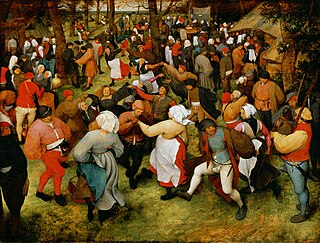
The Wedding Dance is a 1566 oil-on-panel painting by Pieter Bruegel the Elder. Owned by the museum of the Detroit Institute of Arts in Detroit, Michigan, the work was discovered by its director in England in 1930, and brought to Detroit. It is believed to be one of a set of three Bruegel works from around the same time: The Wedding Dance, The Peasant Wedding (1567) and The Peasant Dance (1569).

Battle Between Carnival and Lent is an oil painting by Dutch artist Jan Miense Molenaer, located in the Indianapolis Museum of Art in Indianapolis, Indiana. Painted ca. 1633–1634, it depicts a brawl between rowdy peasants, representing Carnival, and a group of monks, representing Lent. The rowdy combatants are armed with comical implements representing their sides, such as a peasant with a beer tankard battling a monk armed with fish.
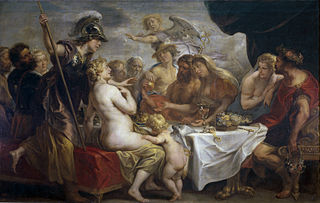
The Feast of the Gods or Banquet of the Gods as a subject in art showing a group of deities at table has a long history going back into antiquity. Showing Greco-Roman deities, it enjoyed a revival in popularity in the Italian Renaissance, and then in the Low Countries during the 16th century, when it was popular with Northern Mannerist painters, at least partly as an opportunity to show copious amounts of nudity.

Tobias' Journey is an oil-on-panel painting by Flemish artist Joos de Momper. The painting showcases Momper's large scale, imaginary landscape painting and his interpretation of perspective in distant views while at the same time treating a biblical subject. The painting depicts the story of Tobit, a righteous Israelite of the tribe of Naphtali, living in Nineveh, who is sent to recover is father's money to Media, escorted by the Archangel Raphael. The painting is currently housed at the Rockox House in Antwerp.

